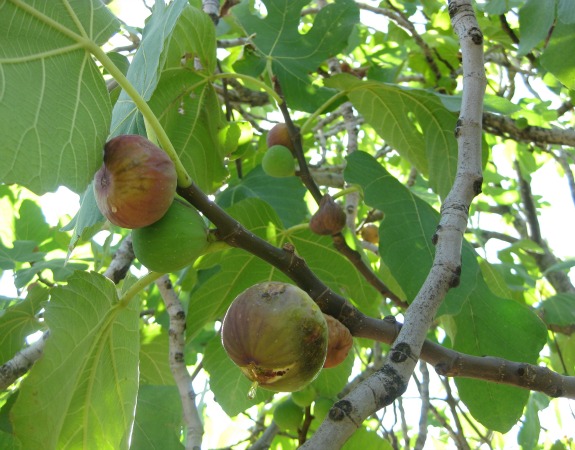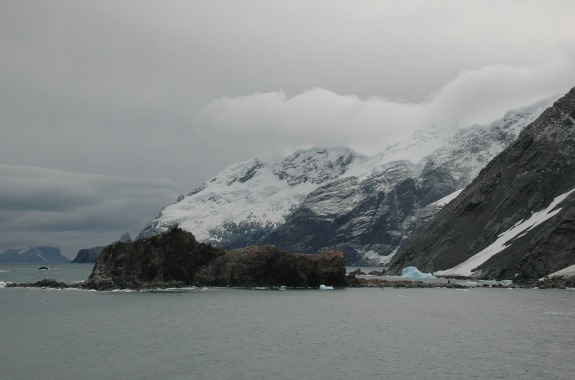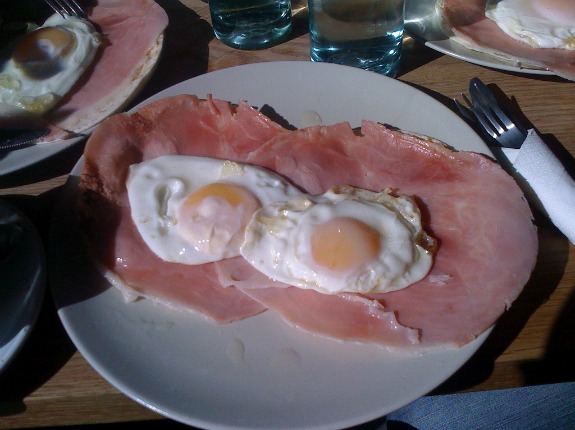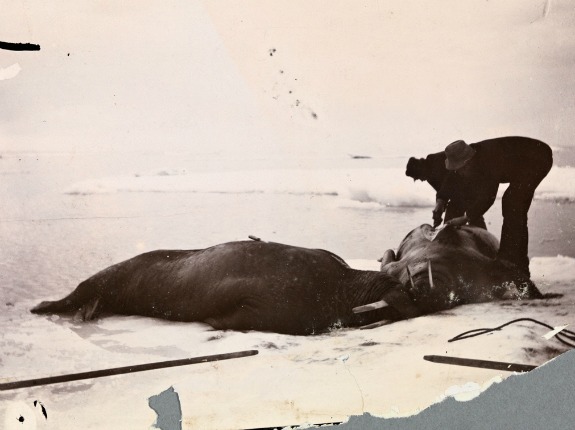The Meals That Starving Travelers Dream Of
Daydreaming of food is a tradition as old as the saga of man versus wild. What would you wish to eat if you were starving in a tent or a dinghy at sea?
The mahi mahi, also called dorado and dolphin fish, is a recurring character in stories of sailors lost at sea, many of whom have used crude, makeshift fishing gear to bring this beautiful—and tasty—creature aboard. Photo courtesy of Flickr user mag1965.
What would you want to eat if you were starving on a dinghy lost at sea? In the 2001 novel Life of Pi, adapted as a movie now in theaters, the castaway protagonist, a 16-year-old Indian boy nicknamed Pi, spends the better part of a year on a lifeboat—and one day as he reaches a near-death pinnacle of hunger, suffering and delirium, he envisions a tree full of ripe figs. “‘The branches…are bent over, they are so weighed down with figs,’” Pi drones to himself in reverie. “‘There must be over three hundred figs in that tree.’” Readers are convinced: Perhaps nothing beats a fig for a starving man.
Life of Pi is fiction, but daydreaming of food is a real-life tradition as old as the saga of man against the elements. If we scour the pages of the many books about grueling expeditions across land and sea, we find an impassioned menu of sweet and savory delights to make the mouth water. In his 1986 memoir Adrift, author Steve Callahan—a sailor who was lost at sea for 76 days in 1982—sets a lavish table of dreams on page 108: “I spend an increasing amount of time thinking about food. Fantasies about an inn-restaurant become very detailed. I know how the chairs will be arranged and what the menu will offer. Steaming sherried crab overflows flaky pie shells bedded on rice pilaf and toasted almonds. Fresh muffins puff out of pans. Melted butter drools down the sides of warm, broken bread. The aroma of baking pies and brownies wafts through the air. Chilly mounds of ice cream stand firm in my mind’s eye. I try to make the visions melt away, but hunger keeps me awake for hours at night. I am angry with the pain of hunger, but even as I eat it will not stop.” (Film director Ang Lee consulted Callahan during the making of Life of Pi for accuracy in portraying the hardships of being lost at sea.)

A tree full of figs: This is what the protagonist in the novel Life of Pi, recently released as a film, dreamed of at the climax of his hunger, after months at sea and a diet heavy in fish—including mahi mahi. Photo by Alastair Bland.
Men Against the Sea, the historical fiction account of the sailors cast away on a lifeboat by the mutineers of HMS Bounty, is a novella steeped in stomach-scraping hunger. At one point, a man named Lawrence Lebogue exclaims after a failed skirmish with a huge sea turtle he had nearly pulled into the boat, “‘A monster…all of two hundredweight! … To think of the grub we’ve lost! Did ‘ee ever taste a bit of calipee?’” (Calipee is a main ingredient in turtle soup.) Moments later, Capt. William Bligh tells the crew’s botanist, David Nelson, of the feasts he sat in on in the West Indies. Bligh describes “‘their stuffing and swilling of wine. Sangaree and rum punch and Madeira till one marveled they could hold it all. And the food! Pepper pot, turtle soup, turtle steaks, grilled calipee; on my word, I’ve seen enough, at a dinner for six, to feed us from here to Timor!’”
Bligh and the loyal men of the Bounty lived like princes compared with those of the Essex, the Nantucket whaling ship rammed and sunk by an angry bull sperm whale in 1820. In Owen Chase’s autobiographical account of the ordeal, part of the book The Loss of the Ship Essex, Sunk by a Whale, the first mate holds a mostly dry and colorless course: He tells of how the 20 men journeyed for weeks in their small open boats, racing time, dehydration and starvation. They attempt in vain to kill sharks and porpoises, they land on an island and quickly exhaust its thin resources of bird eggs, and they continue across the open Pacific, hoping always to see a sail while growing ever weaker and emaciated. Through it all, the New Englanders essentially never eat or drink. Finally, Chase pauses in his chronology of dates and coordinates to tell of a moment in which he dozed off: “I dreamt of being placed near a splendid and rich repast, where there was every thing that the most dainty appetite could desire; and of contemplating the moment in which we were to commence to eat with enraptured feelings of delight; and just as I was about to partake of it, I suddenly awoke….” Chase leaves us with our eager forks aloft—and we never learn just what it was that he hoped to eat. Turtle soup, likely. In the following days as the anguished men expired one by one, Chase and his companions resorted to cannibalism. Just eight of the lot were rescued.

When the crew of Ernest Shackleton’s famous expedition spent several months on the bleak Elephant Island, one of the South Shetland Islands, in 1916, they subsisted on seal—and dreamed of pastries. Photo courtesy of Flickr user Rita Willaert.
While stranded for the austral winter of 1916 on the barren Elephant Island, one of the South Shetland Islands, after escaping from Antarctica in three tiny lifeboats, the crew of Ernest Shackleton’s Endurance expedition passed the time reading through a Penny Cookbook that one of the men had kept dry through many months of dire tribulations. And how that book made them dream! The men had been living for months on seal (and sled dog) meat, and Thomas Ordes-Lee, the expedition’s ski expert and storekeeper, wrote in his journal, “e want to be overfed, grossly overfed, yes, very grossly overfed on nothing but porridge and sugar, black currant and apple pudding and cream, cake, milk, eggs, jam, honey and bread and butter till we burst, and we’ll shoot the man who offers us meat. We don’t want to see or hear of any more meat as long as we live.” Their carb cravings were more apparent when one man—the surgeon James McIlroy—conducted a poll to see what each sailor would have to eat if he could choose anything. Their answers included apple pudding, Devonshire dumpling, porridge, Christmas dumpling, dough and syrup and a fruit tart—with most of these dolloped with cream. Just two men wished for meat (pork was their choice), while one with a bleaker imagination said he just wanted bread and butter. For three more months until their rescue, they ate seal and rehydrated milk.
Author Jon Krakauer tells us in his 1990 Eiger Dreams of the time 15 years before that he and a climber friend named Nate Zinsser were holed up during a storm while ascending a new route up the 10,335-foot peak Moose’s Tooth, in Alaska. Dreaming of food, Zinsser said, “If we had some ham, we could make ham and eggs, if we had some eggs.” In The Worst Journey in the World, Apsley Cherry-Garrard, an expedition member on Robert Scott’s doomed Antarctic voyage of 1901-1903 on the Discovery, recalls one frigid winter’s day, saying, “And I wanted peaches and syrup—badly.” And Felicity Aston, a modern explorer from Britain whom I interviewed last January about her solo ski trip across Antarctica, recalled as a highlight of her journey receiving a gift of a nectarine and an apple upon reaching the South Pole research station.

The dish of dreams: “If we had some ham, we could make ham and eggs, if we had some eggs.” That’s what famished mountain climber Nate Zinsser said to pal (and author) Jon Krakauer in 1975 while the men were holed up in a tent during a summer storm on a mountain in Alaska. Photo courtesy of Flickr user mrlerone.
There was no food shortage on the Norwegian research vessel Fram, which Fridtjof Nansen captained into the Arctic Ocean in 1893. His sturdy boat was built with a fortified hull under the plan that she would become frozen in the sea ice and thereby allow Nansen to track the drift of the ice layer by watching the stars—classic, rock solid science in the golden age of discovery. It was a planned “disaster” voyage—and the men went prepared. Nansen, who finally stumbled home again in 1896 caked in campfire soot and seal grease, wrote in his 1897 memoir Farthest North that the expedition carried at the outset several years’ worth of canned and dried foods of numerous sorts. Only during foot or skiff expeditions away from the boat—such as Nansen’s long hike home—did the team members experience great monotony of diet. On one outing, they forgot butter to slab on their biscuits and so named the nearest land “Cape Butterless.” They lived during longer forays on seal, walrus and polar bear—pinniped and bear for breakfast, lunch and dinner; so much pinniped and bear that the reader feels an itch to floss his teeth and scrub down with dish detergent. Meanwhile, Nansen stops to take depth soundings, sketch fossils, study rock strata and express interest in every piece of possible data—and though the pragmatic scientist never does slip into a shameless food fantasy, we know he had them.
If you’d been in Nansen’s boots, what would you have piled on your plate?
/https://tf-cmsv2-smithsonianmag-media.s3.amazonaws.com/accounts/headshot/Off-Road-alastair-bland-240.jpg)


/https://tf-cmsv2-smithsonianmag-media.s3.amazonaws.com/accounts/headshot/Off-Road-alastair-bland-240.jpg)